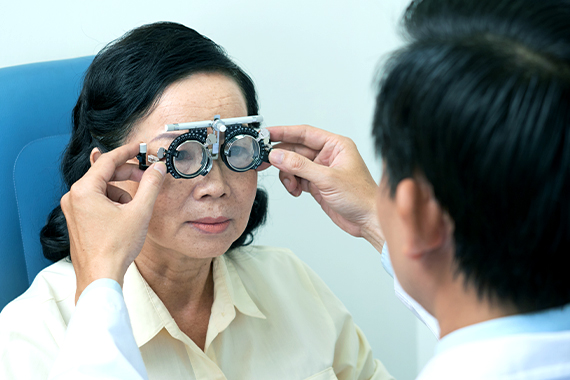Low vision or Low-Sightedness refers to a significant visual impairment that cannot be fully corrected with standard eyeglasses, contact lenses, medication, or surgery. Unlike total blindness, people with low vision have some level of sight but face difficulties performing everyday tasks such as reading, recognizing faces, or navigating environments. This condition can affect one or both eyes and varies in severity, often leading to a reliance on low vision aids or adaptive strategies to maintain independence.

Book Appointment Download Brochure
The symptoms of low vision can vary widely depending on the underlying cause and severity of the impairment. Common signs include:
Trouble reading books, newspapers, or signs, even with corrective lenses.
Persistent blurriness that doesn’t improve with glasses or contact lenses.
Difficulty seeing objects on the side, leading to frequent bumping into objects.
Sensitivity to light or difficulty seeing in dim or bright environments.
Struggling to distinguish between similar colors or shades, particularly in low light.
Problems identifying familiar faces from a distance.
Brighter light is required to carry out daily tasks such as reading or cooking.
It is crucial to consult an eye doctor if you experience any persistent changes in your vision, especially if:
Early detection and management of low vision or low sightedness can help maintain your quality of life and reduce the impact of visual impairment.
Low vision can result from a variety of eye conditions, injuries, or diseases. Common causes include:
A leading cause of vision loss in older adults, affecting the central part of the retina.
A group of eye conditions that damage the optic nerve, often leading to peripheral vision loss.
Vision impairment caused by damage to the blood vessels in the retina due to diabetes.
Clouding of the eye's natural lens, leading to blurry vision, especially in low light.
A genetic disorder that affects the retina and leads to progressive vision loss.
Eye injuries that result in permanent vision loss or impairment.
Severe infections that damage the eye's structure, leading to reduced vision.
Low vision can manifest in different forms, each affecting vision in unique ways:

Difficulty seeing in the center of your visual field, often associated with macular degeneration.

Also known as tunnel vision, this type affects side vision and is commonly linked to glaucoma.

Difficulty seeing in low light or darkness, often due to retinitis pigmentosa or vitamin A deficiency.

General blurriness affecting both near and distant vision, typically caused by cataracts.

The appearance of glare or haze, making it difficult to see in bright light, often related to corneal issues.
Several factors can increase the risk of developing low vision, including:
The risk of low vision increases significantly with age, particularly after 60.
Pre-existing conditions like glaucoma, cataracts, and macular degeneration are major risk factors.
Individuals with diabetes are at higher risk of developing diabetic retinopathy, leading to low vision.
A family history of eye diseases, such as retinitis pigmentosa or glaucoma, increases the likelihood of developing low vision.
Smoking has been linked to an increased risk of developing macular degeneration and other eye diseases.
Long-term exposure to ultraviolet light without protection can increase the risk of cataracts and other vision problems.
While not all causes of low vision can be prevented, certain measures can reduce your risk:
Schedule regular comprehensive eye exams, especially if you have a family history of eye conditions.
Keep chronic conditions like diabetes and high blood pressure under control to reduce the risk of associated eye problems.
Wear sunglasses that block UV rays and protective eyewear during activities that could lead to eye injury.
If you smoke, quitting can reduce your risk of developing age-related macular degeneration and other eye conditions.
A diet rich in leafy greens, fish, and other foods high in omega-3 fatty acids can support eye health.
Low vision is a challenging condition that significantly impacts daily life, but with the right management and support, individuals can maintain their independence and quality of life. Understanding the symptoms, causes, and risks associated with low vision, as well as taking preventive measures, can help in early detection and effective management. If you or someone you know is experiencing symptoms of low vision, it is essential to seek professional medical advice promptly to explore the available options for care and support.
While Shree Ramkrishna Netralaya is your top choice for eye care in Mumbai, you may also consider our other reputable clinics and hospitals near you.
Address:
201 & 202 Elmer #Plot #563, Central Avenue, Corner of, 11th Rd, Chembur, 400071
Phone: 082917 14838
Timing: Mon-Sat- 10 a.m. To 8 p.m.
Address:
Near Risk Care Hospital, Near Makhamali Talao, LBS Marg, Thane, W, Mumbai, Maharashtra 400601
Phone: 02225441139
Timing: Mon-Sat- 11 a.m. To 8 p.m.